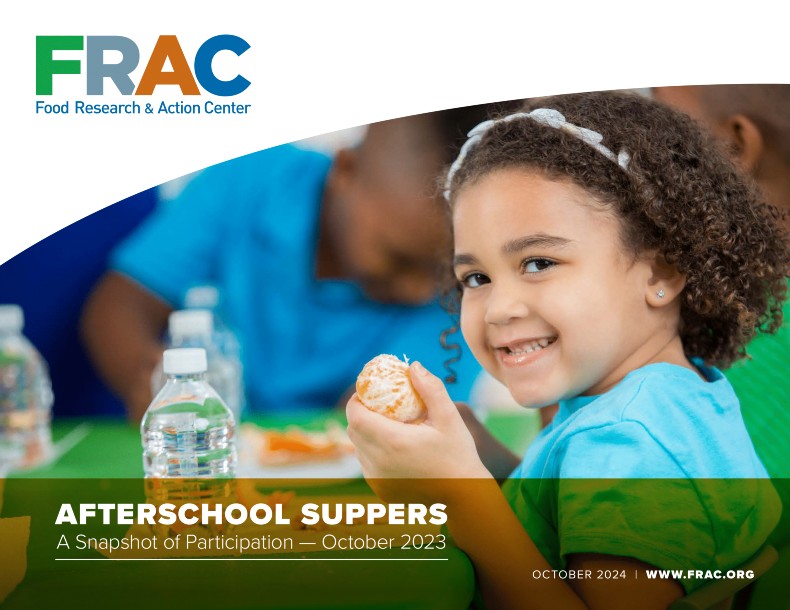Too many children are missing out on afterschool snacks and suppers offered by the Afterschool Nutrition Programs, according to FRAC’s latest report, Afterschool Suppers: A Snapshot of Participation – October 2023.
Key Findings
-
- 1.23 million children received an afterschool supper on an average school day in October 2023, an increase of 73,878 children, or 6.4 percent, when compared to October 2022.
- 1.25 million children received an afterschool snack, an increase of 63,112 children from October 2022.
- 46,308 sites served afterschool suppers and/or snacks in 2023, an increase of 8,075 sites from 2022.

What Are the Afterschool Nutrition Programs?
The Afterschool Nutrition Programs play a critical role in helping to reduce hunger and support high-quality enrichment programs by providing healthy meals and snacks to children to ensure they are fed after school, on weekends, and during school holidays.
Afterschool programs have always been a crucial access point for the nutritious foods that children need to grow and thrive, helping mitigate the risk of learning and social emotional delays.
Afterschool meal providers have done amazing work amid adversity, changing their meal service operations to offer the suppers and snacks that families depend on and finding new ways to feed children.

Did you know?
The Afterschool Snack Programs began in 1998, and suppers became available nationwide in 2010 through the Healthy, Hunger-Free Kids Act.
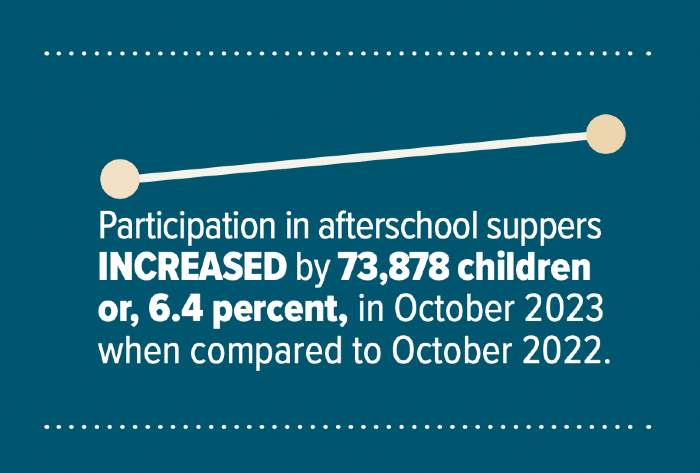
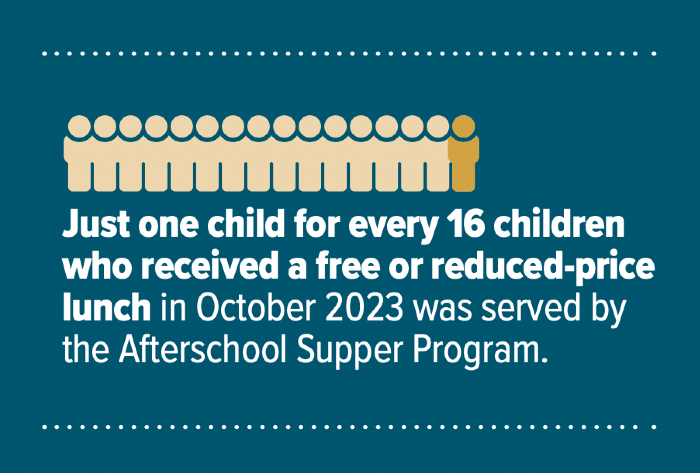
Expanding Afterschool Access
During the pandemic, USDA waivers allowed all families with low incomes in every community to access afterschool meals and snacks. The decrease in participation in 2022 was a result, in part, of the end of these flexibilities.
Yet progress is being made.
-
- The American Rescue Plan, signed into law in 2021, made significant investments in afterschool programs, and
- The U.S. Department of Education’s Engage Every Student Initiative aims to guarantee that every student can access high-quality out-of-school time programs.
The slight participation increases seen in 2023 indicate that afterschool programs are beginning to recover from the pandemic. Strategic and deliberate investments are crucial to help the Afterschool Nutrition Programs effectively expand to meet increasing needs.

Lights On Afterschool
FRAC is proud to be a partner of Lights On Afterschool, October 24, 2024. Led by the Afterschool Alliance, the day offers the opportunity to highlight the importance of afterschool programs and their connection to the Afterschool Nutrition Programs.
Federal Policy Recommendations
- Streamline the Afterschool Meal Program and Summer Food Service ProgramAllowing sponsors to operate one program year-round through the Summer Food Service Program would reduce redundant paperwork and support sponsors in serving more children effectively.
- Allow School Food Authorities to Serve Suppers Through the National School Lunch ProgramCongress should streamline the Afterschool Nutrition Programs to allow schools to provide up to a meal and a snack any day during the regular school year through the National School Lunch Program.
- Lower the Area Eligibility ThresholdLowering the eligibility threshold would improve access to suppers in every state.
State and Local Policy and Program Opportunities
- Mandate ParticipationMany states have advanced efforts to mandate participation in the School Breakfast Program and Summer Food Service Program to ensure that schools in low-income areas provide meals to eligible children. This trend is gaining traction in afterschool nutrition as well, with Virginia and Maine leading the way by passing legislation that requires schools running afterschool programs to participate.
- Allocate FundingA few states allocate funding to support school and summer meal programs, including supplementing the federal reimbursement or providing grants for start-up or equipment costs. States should also consider including funding for afterschool suppers and snacks. Now that the American Rescue Plan funding has ended, it is vital that state funding for afterschool programming is prioritized.
- Recruit School DistrictsSchool nutrition departments are well-equipped and experienced in running federal child nutrition programs effectively. Many schools already host formal afterschool programs as well as informal activities and clubs that fulfill the requirement to provide educational or enrichment opportunities. To increase participation among school nutrition departments, state agencies and advocates can reach out to eligible schools, identify any obstacles to participation, and help schools address these challenges.
- Serve Suppers Instead of (Or In Addition to) SnacksOne of the most straightforward ways to combat student hunger and enhance nutrition is for afterschool programs to offer supper. If the program runs long enough, it can provide both supper and a snack. Additionally, by not including supper, sponsors and sites forfeit the opportunity for significantly higher federal reimbursements, which could make the afterschool nutrition program more financially sustainable.
- Improve Meal Quality and AppealAll suppers and snacks provided through the Afterschool Nutrition Programs must adhere to federal nutrition standards. Sponsors can enhance the quality of the meals they offer by following FRAC’s Afterschool Standards of Excellence, as well as by incorporating fresh, seasonal produce through Farm to Afterschool initiatives.
- Reduce BarriersFor instance, long travel distances can make it difficult for some children to stay after school, even if programs are available. To address this issue, schools can adjust bus schedules to accommodate meal service and enrichment activities before buses depart. Additionally, schools can consider combining meals in the classroom with homework help after the bell rings, and delay the time that the school buses depart.
Afterschool Resources
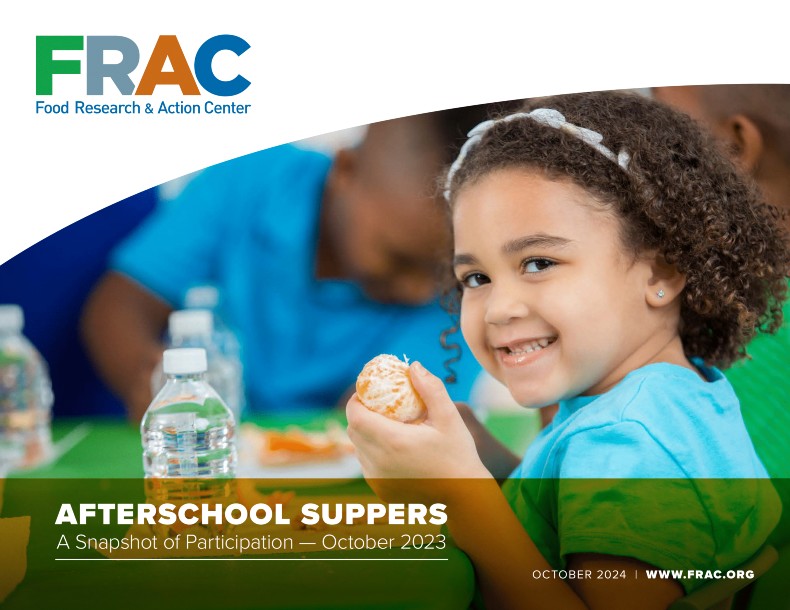
Afterschool Suppers: A Snapshot of Participation – October 2023
Read the report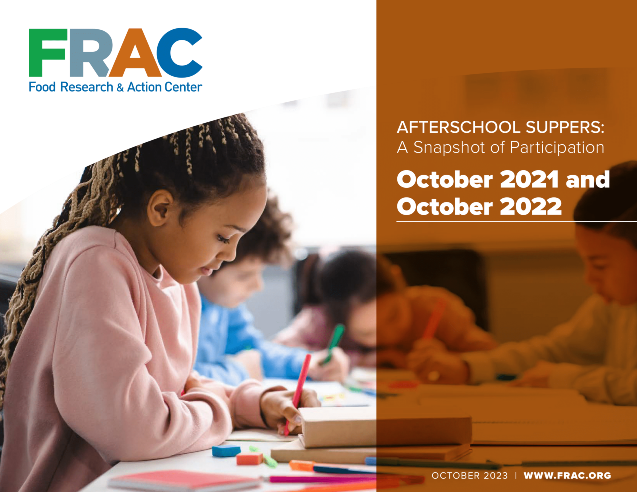
Afterschool Report, 2021 and 2022
Read our last report on afterschool meals and snacks
Communications Toolkit
Spread the word!

